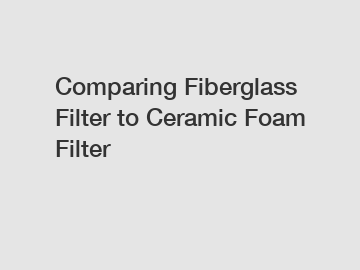Jan. 13, 2024
Minerals & Metallurgy
HEBEI CANGCHEN Product Page
Filtration is an essential process in numerous industries, ensuring the removal of impurities and contaminants from various substances. When it comes to choosing the right filter for your specific application, a myriad of options is available. In this blog, we will compare two widely used filters: the fiberglass filter and the ceramic foam filter. Each filter possesses its own unique characteristics and benefits, and by understanding their differences, you can make an informed decision for your filtration requirements.
Fiberglass Filters:

Fiberglass filters have been a popular choice for many years due to their affordability and effectiveness. Made from bonded strands of spun glass, these filters are known for their high particulate removal efficiency. Their dense structure allows them to capture particles as small as 1 micron in size, making them ideal for air and liquid filtration applications.
The benefits of fiberglass filters lie in their low resistance to airflow, which maximizes their overall performance. Additionally, they are compatible with a wide range of chemicals and exhibit excellent thermal stability, retaining their efficiency even in high-temperature environments. Fiberglass filters are also easy to handle and maintain, providing convenience to users.
Ceramic Foam Filters:
Ceramic foam filters, on the other hand, are a newer technology gaining popularity in filtration systems. These filters are made from a highly porous ceramic material, creating a three-dimensional network structure that facilitates efficient filtration. The interconnected pores allow the passage of gases and liquids while capturing solid particles, resulting in excellent filtration performance.
One of the standout advantages of ceramic foam filters is their exceptional resistance to thermal shock and high temperatures, making them suitable for demanding applications such as molten metal filtration in the foundry industry. Additionally, their chemical stability ensures compatibility with various corrosive substances. Ceramic foam filters also have a longer lifespan than fiberglass filters, making them a cost-effective choice in the long run.
Comparing Efficiency and Filtration Capacity:
When it comes to filtration efficiency, both filters have their strengths. Fiberglass filters are highly effective in capturing tiny particles, making them a preferred choice in air conditioning systems and HVAC units. However, as the particles accumulate in the dense structure of the fiberglass filter, their airflow capacity decreases and may require frequent replacement, potentially increasing maintenance costs.
Ceramic foam filters, with their three-dimensional open-cell structure, offer a higher dirt-holding capacity. The interconnected pores allow for better flow and reduce filter clogging, resulting in prolonged service life and fewer replacements. This advantage makes ceramic foam filters a preferred choice for applications where large amounts of particulate matter need to be trapped without compromising filtration efficiency.
Environmental Impact and Sustainability:
Considering environmental factors, ceramic foam filters provide an eco-friendly solution compared to their fiberglass counterparts. Fiberglass filters, while effective, contribute to landfills due to their non-recyclable nature. Ceramic foam filters, however, can be recycled and reused, helping to reduce waste and environmental impact.
Conclusion:
Choosing the right filter for your specific application requires careful consideration of factors such as filtration efficiency, resistance to thermal shock, durability, and environmental impact. Fiberglass filters excel in capturing tiny particles and maintaining thermal stability, while ceramic foam filters offer higher dirt-holding capacity and recyclability.
Ultimately, your choice will depend on your filtration needs and the specific conditions of your application. Whether you prioritize cost-effectiveness, long-term sustainability, or performance, understanding the differences between fiberglass filters and ceramic foam filters will empower you to make an informed decision. Remember, experts in the field can assist you in selecting the best filter for your requirements, ensuring optimal filtration and peace of mind.
Want more information on fiberglass bag filter? Feel free to contact us.
Previous: Which filter is the best for maximizing efficiency: fiberglass or ceramic foam?
Next: What are the key advantages of Tantalum Wire Mesh for B2B businesses?
If you are interested in sending in a Guest Blogger Submission,welcome to write for us!
All Comments ( 0 )